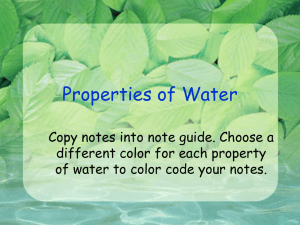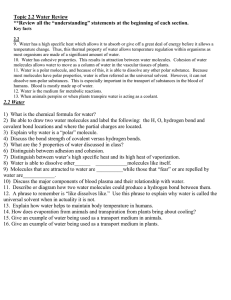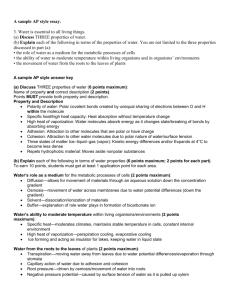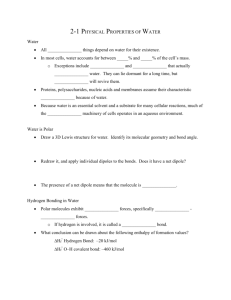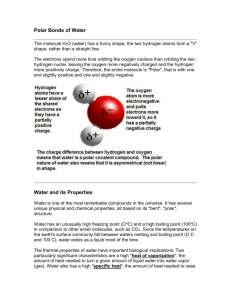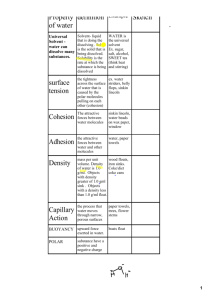SC.912.L.18.12 Properties of Water that contribute to
advertisement
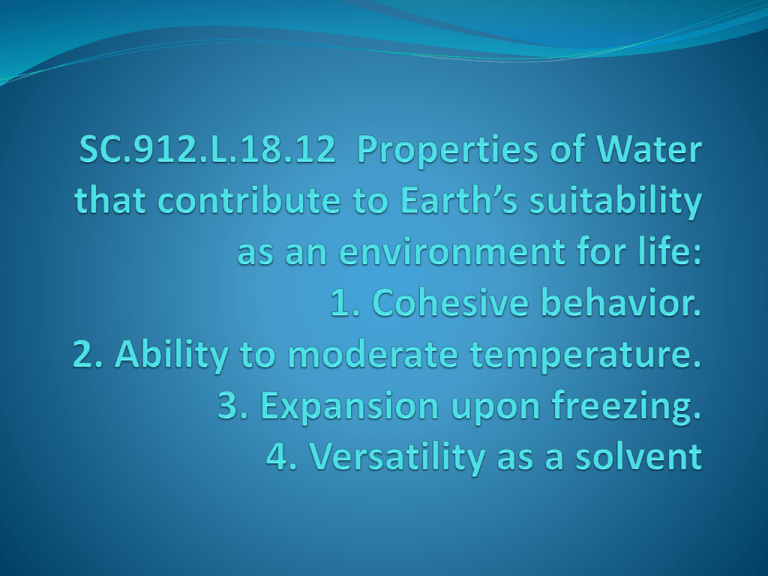
Nature of Water Polar Molecule Nature of Water Physical properties of Water Hydrogen Bonds Cohesion and Adhesion. Cohesion is an attraction between substances of the same kind. The hydrogen bonds between water molecules cause the cohesion of liquid water. A water molecule attracts another water molecule Because of cohesion, water and other liquids form thin films and drops, and flows upward against the force of gravity through the stem of a plant Adhesion is an attraction between different substances. Water Molecules are attracted to many other similarly polar substances. Adhesion powers a process, called capillary action, in which water molecules move upward through a narrow tube, such as the stem of a plan. Ability to Moderate Temperatures Water absorbs heat more slowly and retains this energy longer than many other substances do. The ability of water to store heat longer than other substances do allows organisms to maintain a stable internal temperature. During daytime the oceans remove heat energy from the atmosphere, at night the oceans release the heat. Water plays an important role regulating temperatures on Earth Expansion Upon Freezing Water expands and becomes less dense when it Freezes (density of liquid water 1 g/ml, density of ice 0.94 g/ml) Many fish and aquatic plants can survive a cold winter because the layer of ice that forms at the top of a lake insulates the water below and prevents the lake from freezing solid. Versatility as a Solvent A solution is a mixture in which one or more substances are evenly distributed in another substance. The polarity of water enables many substances to dissolve in water. Ionic compounds and polar molecules dissolve best in water. Nonpolar molecules, however, do not dissolve well in water. 1. A florist places a bouquet of white carnations in water containing blue dye. After a time, the flowers turn blue. What process helped the carnations to change color? A. water’s ability to form crystals B. ability of H2O to dissolve NaCl C. cohesion and adhesion of water molecules D. formation of covalent bonds between hydrogen and oxygen molecules 2. Which of these statements correctly explains why water is a good solvent for many ionic compounds? F. Water is a polar compound. G. Water is an ionic compound. H. Water molecules are nonpolar. I. Water molecules completely separate into ions in solution. 4. Which of the following is not a unique property of water? F. Water molecules stick together by cohesion. G. Frozen water is less dense than liquid water. H. Water molecules stick to other polar substances. I. Hydrogen bonds allow water to heat and cool very quickly. 3. What is the attractive force between two of the same kind of particle? A. adhesion B. capillary action C. cohesion D. polarity 5. Water has the ability to store heat longer than other substances. What benefit does this property of water provide to organisms? A. It provides the ability to dissolve nonpolar compounds. B. It provides the appropriate catalyst for chemical reactions. C. It enables organisms to function with a higher cellular pH. D. It allows organisms to maintain a stable internal temperature. 6. Many fish and aquatic plants can survive a cold winter because the layer of ice that forms at the top of a lake insulates the water below and prevents the lake from freezing solid. What unique property of water contributes to this effect? F. Water absorbs heat when it evaporates and forms a gas. G. Water expands and becomes less dense when it freezes. H. Water molecules completely separate into ions in solution. I. Water forms hydrogen bonds with ions and other polar substances. 7. Water is essential for life. Its special properties make water the single most important molecule in plant life. Which of the following properties of water enables it to move from the roots to the leaves of plants? A. Water expands as it freezes. B. Water is an excellent solvent. C. Water exhibits cohesive behavior. D. Water is able to moderate temperatures.
